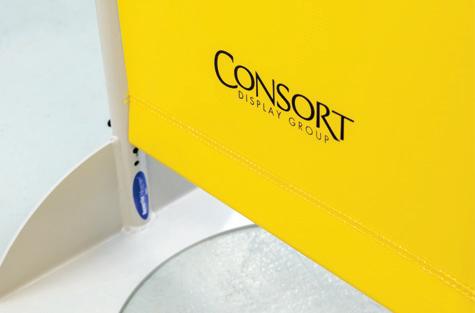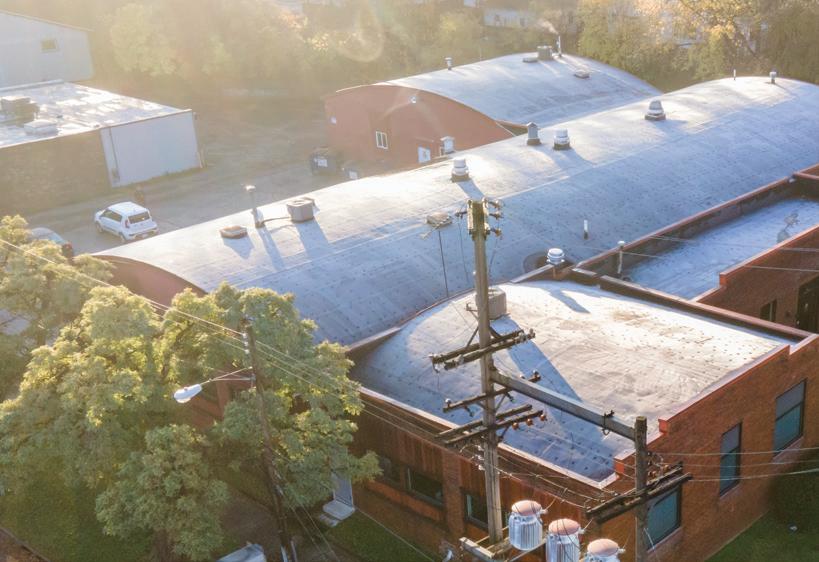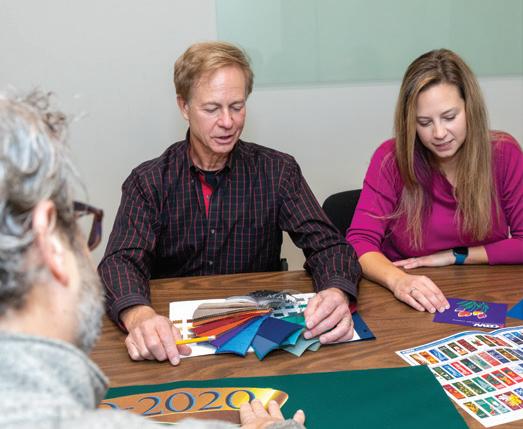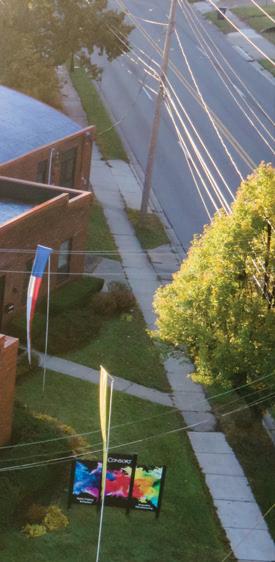
4 minute read
A BANNER YEAR
from Raven Issue No. 33
Kalamazoo Banner Works Partners With Sunbrella For Digital Printing Innovation
It started with a simple enough request when, in the early 1980s, the city of Kalamazoo, Michigan, asked Roger Lepley to take on the design and installation of the city street banners, asking specifically for banners “like they have in Chicago.”
Advertisement
Lepley, a licensed architect, took on the project as the 1980 recession zapped the Kalamazoo-area architecture job market and soon found his training in design thinking applicable to the process. With this first project, he saw opportunities to take the Chicago model and make it even better.

“I realized the hardware Chicago was using was primitive and awkward, so I immediately designed adjustable hardware using fiberglass rods to help spill wind and reduce wind force on the banner and utility pole,” Lepley said. “Therefore, a banner company, Kalamazoo Banner Works, was born.”
Since 1983, Kalamazoo Banner Works, which now falls under parent company Consort Display Group, has focused on the design and manufacture of verticalformat street banners and hardware. The banner designs are screen printed on Sunbrella ® fabrics and commissioned by cities, cultural organizations, festivals, universities and more.
To make a screen-printed banner, the team makes a large screen out of two-by-fours with mesh stapled over it. The screen is then covered in photo emulsion paste and allowed to dry. After drying, the screendesign stencil is placed over emulsion and the screen is exposed to light, burning the design into the mesh. The design portion is then washed away, leaving the mesh holes for the ink to seep through onto the banner fabric. The screen is placed on the banner, and an ink color is squeegeed over it, one color at a time. To dry the ink, the banner runs through a 330° Fahrenheit oven for 45 seconds. This step is repeated for each color on both sides of the banner. A banner order may include anywhere from 20 to 200 identical banners.
The process typically takes a team of at least four people and is relatively time and labor intensive. While digital printing is available and widely used in the industry, it’s typically on vinyl material because most of the printers can’t adequately print onto a fabric. Screen printing is a laborious process, but Lepley says the quality of printed vinyl just isn’t the same as a Sunbrella® fabric banner.

“We are a design-oriented manufacturing company, and our banners are installed outside in all kinds of nice and nasty weather, so durability is a must,” Lepley said. “Sunbrella is really an amazing outdoor textile, and it deserves the reputation that it has for strength and UV resistance. It also offers lots of colors from which to choose.”
Rather than forgo the material, Lepley knew it was time for another product innovation: Find a digital printer of the right size and equipped with the right ink to print on Sunbrella fabric. He reached out to his Glen Raven Custom Fabrics regional sales representative, Dan Litster, for help in the research process. Litster set up appointments with three printer companies and attended daylong appointments with Lepley and his team to research printer capabilities.
“We traveled to each printer company and spent the day there,” Litster said. “We ran tests with swatches of Sunbrella fabrics in different colors, printing the same image repeatedly with different equipment and inks to see how good a quality we could get.”
To test the quality immediately, the team took to the unofficial fingernail and credit card test, scraping an edge against the ink to test for flaking. Prints that made it through that initial experiment were then sent to Glen Raven to undergo additional testing, such as the Martindale abrasion test, which uses a machine to vigorously and repeatedly apply friction to the test fabric for wear, tear and flaking on the design. It proved more difficult for most of the inks, which flaked and rubbed off the performance fabric.
“Dark and colorful fabric backgrounds require a dense white ink that saturates the fabric rather than caking on top of it,” Lepley said. “The industry is making advancements with background ink, but it’s not common to find an adequate white ink.”

Lepley left the first two visits discouraged, as the prints needed to withstand harsh outdoor elements for multiple seasons but weren’t passing the flaking tests. The third time, as they say, was the charm though, and they found a printer that was able to withstand the rigorous testing and quality standards in the Toronto-based Agfa printing company.

“I really appreciate that Glen Raven took this research so seriously that they were physically present,” Lepley said. “And after we discovered that the Agfa machine would print the way we needed, the Glen Raven folks performed durability and UV testing of the ink on the fabric. That was a huge bonus and time and money saver for us. I believe that assistance was instrumental in us being able to have the project up and running by the first of 2020.”
The printer that passed the test? Agfa’s Jeti Tauro H2500 LED printer, a robust hybrid UV inkjet system that features speeds up 275 square meters per hour (2,960 square feet per hour) and prints up to 2.54 meters (100 inches) wide. With the high-quality background ink, the printer also allows the use of multiple vibrant pigments, which are UV cured in the machine instead of heat cured in a separate oven.
“We believe we are currently the only banner company that is roll-to-roll printing Sunbrella for exterior use,” Lepley said. “Of course, we are printing Sunbrella not only for the banners but also for awning companies and some marine projects, which are well-known users of Sunbrella.”
In total, there are nine unique brands that fall under Lepley’s Consort Display Group, as well as another outdoor product line, Dori Pole Pennant System, which features durable, colorful, floating fabric that lasts through both light breezes and strong windstorms. From fabric banners to modern furniture, Lepley has built many businesses on creativity and dedication to quality. With this latest innovation, Lepley will be able to continue and grow Kalamazoo Banner Works operations.
“I believe our greatest strength is our drive for innovation,” Lepley said. “We don’t really want to do what anybody else is doing, if possible. Our product lines are generally unique in the world, and the Sunbrella/Agfa connection has helped us stay unique in the very competitive street banner market.”
On the web at consort.com






